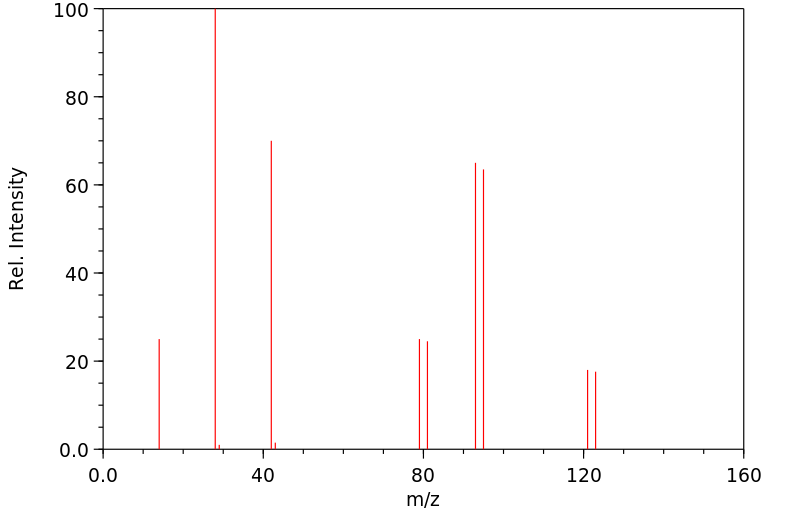溴叠氮化物 | 13973-87-0
中文名称
溴叠氮化物
中文别名
——
英文名称
bromine azide
英文别名
——
CAS
13973-87-0
化学式
BrN3
mdl
——
分子量
121.924
InChiKey
KFCUPNHUPHDVJC-UHFFFAOYSA-N
BEILSTEIN
——
EINECS
——
-
物化性质
-
计算性质
-
ADMET
-
安全信息
-
SDS
-
制备方法与用途
-
上下游信息
-
文献信息
-
表征谱图
-
同类化合物
-
相关功能分类
-
相关结构分类
物化性质
-
熔点:~45℃ [HAW93]
-
沸点:explodes [HAW93]
计算性质
-
辛醇/水分配系数(LogP):2.3
-
重原子数:4
-
可旋转键数:0
-
环数:0.0
-
sp3杂化的碳原子比例:0.0
-
拓扑面积:14.4
-
氢给体数:0
-
氢受体数:2
安全信息
-
危险等级:1.1A
-
危险类别:1.1A
-
储存条件:库房应保持通风、低温和干燥的环境,并将这些物品与其他物质如锑、乙醚、银、金属和还原剂分开存放。
SDS
制备方法与用途
反应信息
-
作为反应物:描述:溴叠氮化物 生成 氨基溴参考文献:名称:Radiative and collisional decay of NBr(b 1Σ+, v’)摘要:NBr(b 1Σ+, v′), v′≤10 is produced by photolysis of BrN3 at 193 nm. Using this method, radiative decay rates for v′=0, 2, and 5 of the b 1Σ+ state were measured and were found to be ∼2.5×104 s−1. The rate constant for NBr(b) quenching by collisions with BrN3 was determined to be 1.57×10−10 cm3 s−1 for v′=0 and slightly faster for v′>0. The nascent vibration distribution of NBr(b 1Σ+) produced by 193 nm photolysis of BrN3 was found to be inverted, with a maximum population in v′=2. The overall quantum yield for production of NBr(b 1Σ+) by the photodissociation is 0.12.DOI:10.1063/1.449908
-
作为产物:参考文献:名称:叠氮化溴的固态结构摘要:一个新的扭曲:描述了BrN 3的单晶结构分析。与形成链的IN 3相比,BrN 3在固态下形成螺旋结构(参见图片)。这种结构特征以前从未在共价p-嵌段叠氮化物化学中观察到。DOI:10.1002/anie.201108092
-
作为试剂:描述:反式-1,2-二苯乙烯 在 溴叠氮化物 作用下, 生成 erithro-1-azido-2-bromo-1,2-diphenylethane参考文献:名称:Zbiral,E.; Keschmann,E., Justus Liebigs Annalen der Chemie, 1972, vol. 758, p. 72 - 83摘要:DOI:
文献信息
-
6.alpha., .beta.-Substituted penicillin derivatives申请人:Merck & Co., Inc.公开号:US04035359A1公开(公告)日:1977-07-12Novel 6-methoxy and 6-thioalkyl-6-acylamido-penicillanic acids and their non-toxic pharmaceutically-acceptable salts, esters and amides which are useful as antibiotics. The products are prepared by treating an ester of 6-substituted-6-aminopenicillanic acid with an acylating agent followed by removal of the ester group. Also disclosed are novel intermediates.
-
Derivatives of 6-aminopenicillanic acid申请人:Merck & Co., Inc.公开号:US04071529A1公开(公告)日:1978-01-31Novel 6-methoxy and 6-thioalkyl-6-acylamidopenicillanic acids and their non-toxic pharmaceutically-acceptable salts, esters and amides which are useful as antibiotics. The products are prepared by treating an ester of 6-substituted-6-aminopenicillanic acid with an acylating agent followed by removal of the ester group. Also disclosed are novel intermediates.
-
Low viscosity azide-containing mono and dicationic ionic liquids with unsaturated side chain作者:Reza Fareghi-Alamdari、Razieh HatefipourDOI:10.1016/j.molliq.2016.11.006日期:2017.1A new class of azide-functionalized monocationic and unsymmetrical dicationic ionic liquids (ILs) with low viscosity and high liquid range was synthesized. All of the synthesized ILs, were characterized by FT-IR, 1HNMR, 13CNMR spectroscopies and elemental analysis. Some thermophysical properties including melting point, density, shear viscosity, decomposition temperature and heat capacity of the unsymmetrical
-
Fluorescent chemosensors for metals based on dipyrrins申请人:Bentley Paul A.公开号:US20080182333A1公开(公告)日:2008-07-31The present invention is a new class of fluorescent sensor with unprecedented sensitivity, selectivity and synthetic efficiency for the identification and qualitative and quantitative detection of transition metal ions. The chemosensing properties are based on an internal charge transfer mechanism or photo-induced electron transfer and are effective in vitro. The chemosensor comprises one or more electron donating dipyrrin functionalities linked to an electron withdrawing functionality. The chemosensor forms a stable transition metal complex through internal charge transfer between the electron donating functionality and the target transition metal, which results in measurable fluorescence. Specific examples for sensing zinc and copper ions are described.
-
Gmelin Handbuch der Anorganischen Chemie, Gmelin Handbook: Ag: MVol.B1, 4.3.6.8, page 165 - 166作者:DOI:——日期:——
表征谱图
-
氢谱1HNMR
-
质谱MS
-
碳谱13CNMR
-
红外IR
-
拉曼Raman
-
峰位数据
-
峰位匹配
-
表征信息
同类化合物
高碘酸
氟化氘
过氯酰氟
过氧二硫酰氯
肼二氢溴酸盐
肼二氟化物
联氨-d4氯化氘
联氨-15N2二盐酸盐
羟铵氟化物
羟胺二氢氟酸盐
羟基胺氢碘酸盐
磺酰氯
磷酰胺叠氮化亚胺氯化(9CI)
磷酰氟
碘叠氮化物
碘化氮
碘化氢(~121~I)
碘化氘
碘123
硫酰碘
硫酰氟
硫光气
硝酰氟
硝基溴
盐酸肼
盐酸羟胺-D3
盐酸羟胺-15N
盐酸羟胺
盐酸
焦硫酰氟
溴叠氮化物
溴化铵-15N
溴化氧硒
溴化氢(~80~Br)
溴化氢(~75~Br)
溴化氘
氯磺酸
氯磷酰腈
氯氧基氟化物
氯氟磺酰
氯叠氮化物
氯化铵-d4
氯化硫杂氮
氯化硫
氯化氮
氯化亚砜
氯化二硫酰
氯二氟氧膦
氨磺酰碘化(9CI)
氨基磺酰氯







